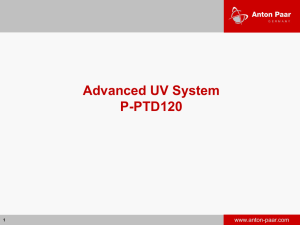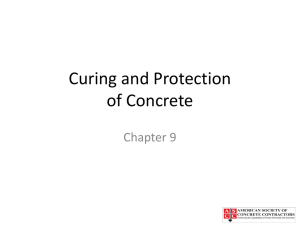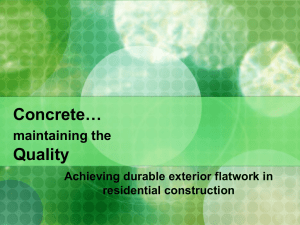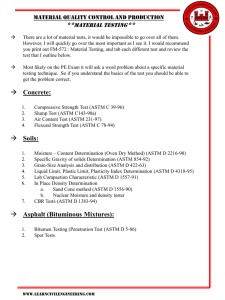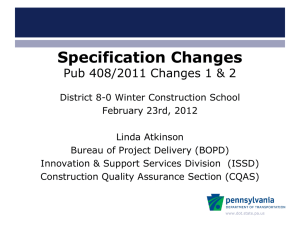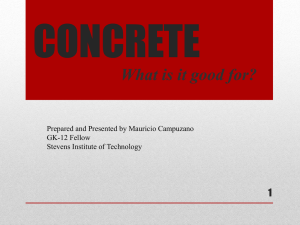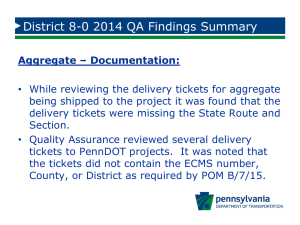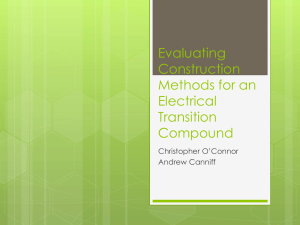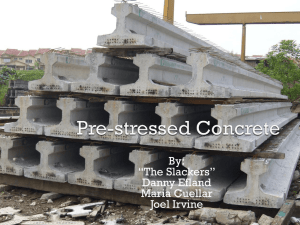CURING OF CONCRETE
advertisement
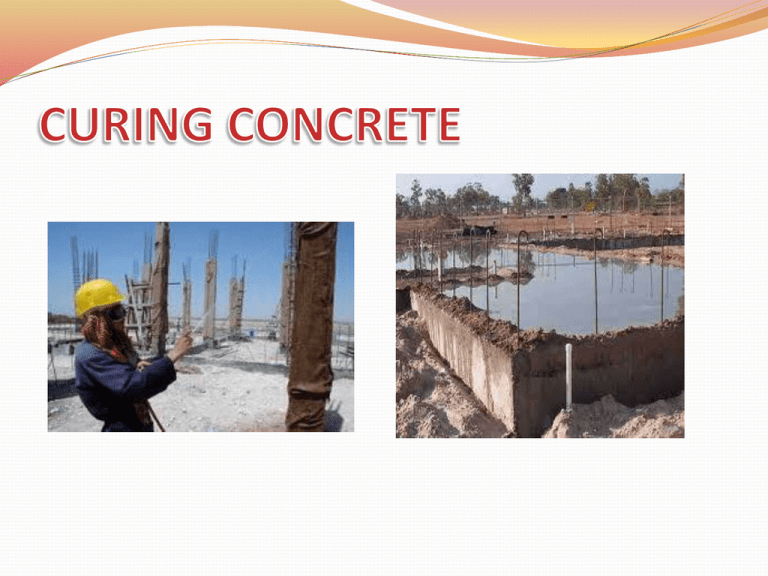
Curing Concrete ( ASTM C31) Curing Concrete What is curing?? Process to retain and maintain for a specific time 1.Moisture(not less than 80%RH) 2.Temperature(above freezing and below 176F or 80C) Essential for cement hydration Hydration What is hydration??? It is a chemical process in which cement ingredients react with water. Tricalcium silicate + Water--->Calcium silicate hydrate+Calcium hydroxide + heat 173.6kJ Dicalcium silicate + Water--->Calcium silicate hydrate + Calcium hydroxide +heat 58.6KJ Hydration (ASTM C186) Hydration (stage I) Almost immediately on adding water some of the clinker sulphates and gypsum dissolve producing an alkaline, sulfate-rich, solution. Stage I Hydration (stage I) the (C3A) phase (the most reactive of the four main clinker minerals) reacts with the water to form an aluminate-rich gel Stage I on the heat evolution curve Hydration (stage I) (C3A) reaction is with water is strongly exothermic but does not last long typically only a few minutes Hydration (stage II) Stage I is followed by a period of a few hours of relatively low heat evolution. This is called the dormant, or induction period. Paste becomes stiff and not workable Hydration (stage III) main period of hydration the alite and belite in the cement start to react formation of calcium silicate hydrate and calcium hydroxide Hydration (stage III) time concrete strengths increase maximum heat evolution occurs typically between about 10 and 20 hours after mixing and then gradually tails off Curing methods 3 main purposes of curing Maintaining mixing water in concrete during the early hardening process 2. 2. Reducing the loss of mixing water from the surface of the concrete 3. Accelerating strength gain using heat and additional moisture 1. First purpose Maintaining mixing water 4 ways Ponding or immersion II. Spraying or fogging III. Saturated wet coverings IV. Left in place forms I. First purpose Maintaining mixing water First way Ponding OR immersion Maintaining mixing water Ponding or Immersion ASTM C192/C192M Ideal for preventing loss of moisture Maintain uniform temperature Disadvantages: Requires considerable labor and supervision Impractical for big jobs First purpose Maintaining mixing water 2nd way Spraying and fogging Spraying or Fogging ASTM C192 Excellent method when temperature is above freezing and humidity is low. Disadvantages: Cost Water erosion of the newly finished concrete form. First purpose Maintaining mixing water 3rd way ASTM C84-36 Saturated wet covering Wet coverings Moisture-retaining fabrics saturated with water i.e burlap, cotton mats, rugs. Advantage 1. no discoloration 2 Resistant to rot and fire Disadvantage Periodic additions of water Use of polythylene film over wet covering will eliminate continuous watering ASTM C171(MATERIAL) First purpose Maintaining mixing water 4th way Left in place forms Maintaining mixing water Left in place forms Advantages No extra cost or labour Easy Disadvantages Risky Extra care in hot weather And wood forms 2nd purpose Reducing loss of water 3 ways Impervious paper II. plastic sheets III. Membrane-forming compounds I. 2nd purpose Reducing loss of water 1st way ASTM C 309. (AASHTO M 148 Covering concrete with impervious paper or plastic sheets Reducing loss of water Impervious paper Two sheets of kraft paper cemented tegether by a bitumious adhesive with fiber reinforcment. Advantages Very efficient for curing horizontal surfaces Periodic addition of water are not required Assures suitable hydration by preventing loss of moisture Reusable Tears and holes can easily be repaired with patches Disadvantage Marginal cost ASRM C171 Reducing loss of water 2nd way Plastic sheets Plastic sheets Polyethylene films, 4-mil thickness Advantages Lightweight Effective moisture barrier Easily applied to complex as well as simple shapes Disadvantages Can cause patchy discoloration More pronounced when film is wrinkled Periodic additions of water may be necessary to prevent discoloration ASTM C 171 2nd purpose Reducing loss of water Applying membrane- forming curing compounds Membrane-forming compound Liquid membrane-forming compounds use to retard or reduce evaporation of water Waxes, resins, chlorinated rubber Advantages hand-operated or power-driven spray equipment One coat 150-200 sft per gallon Disadvantages Extra cost Skilled labour ASTM C309 Efficiency check ASTM ASTM C156 - 09a 3nd purpose Accelerating strength gain 4 ways Curing steam II. Heating coils III. Electrical heated forms or pads IV. Concrete blanket I. 3nd purpose Accelerating strength gain 1st way Steam Curing Advantageous where early strength gain is required, or Additional heat is required to accomplish hydration, ex. cold weather. Two Methods: Live steam (atmospheric pressure) Autoclave (high pressure) Steam curing 3nd purpose Accelerating strength gain 2nd way Heating coils Embedded near surface of concrete elements Prevention from freezing in cold weather 3nd purpose Accelerating strength gain 3rd way Electrical heated forms or pads Primarily used by precast concrete producers Now used in some sensitive projects 3nd purpose Accelerating strength gain 4th way ASTM C167 Concrete blanket Insulate the surfaces in cold temperatures 4300psi 9hours Accelerating strength gain Winter Concrete Curing Blankets Prevents freezing, rapid drying, & cracking all winter Thaw frozen ground prior to pouring Heat spreading technology cures concrete fast Roll it out, Plug it in, the blanket does the rest Accelerate your construction jobs all winter Produces ROCK-HARD concrete every time Maintain optimal curing temperatures year-round Only pennies a day to operate Method Advantage Disadvantage Sprinkling with Water or covering with Burlap Straw Excellent results if constantly kept wet Insulator in winter Moist earth Cheap but messy Likelihood of drying between sprinklings; difficult on vertical walls Can dry out, blow away, burn Stains concrete, can dry out, removal problem Ponding on flat surfaces Excellent results, maintain uniform temperature Requires considerable labor, undesirable in freezing weather Curing compounds Water proof paper Plastic film Sprayer needed; inadequate coverage allows dry out; film can be Easy to apply and inexpensive broken or tracked out before curing is completed; unless pigmented allows concrete to get too hot Heavy cost can be excessive; must be kept in rolls; storage and Excellent protection prevents drying handling problem Should be pigmented for heat protection; requires reasonable ca re and tears must be patched; must Absolutely watertight, excellent be protection. Light and easy to handle weighed down to prevent blowin g away Effects on hardened concrete Increased Strength Watertightness Abrasion resistance Freeze-thaw resistance Volume stability Curing tips ample water do not let it dry dry concrete = dead concrete, all reactions stop can not revitalize concrete after it dries keep temperature at a moderate level concrete with flyash requires longer curing Temperature effects on curing The higher the temperature the faster the curing best temperature is room temperature strongest concrete is made at temperature around 40 F.(not practical) If concrete freezes during the first 24 hrs., it may never be able to attain its original properties. Temperature effects Temperature effects Temperature effects on curing real high temperatures above 120 F can cause serious damage since cement may set too fast. accelerated curing procedures produce strong concrete, but durability might suffer. autoclave curing. Moisture tests Polythene sheet test(ASTM D 4263) Mat Test Test Strip Moisture Meters Gravimetric
